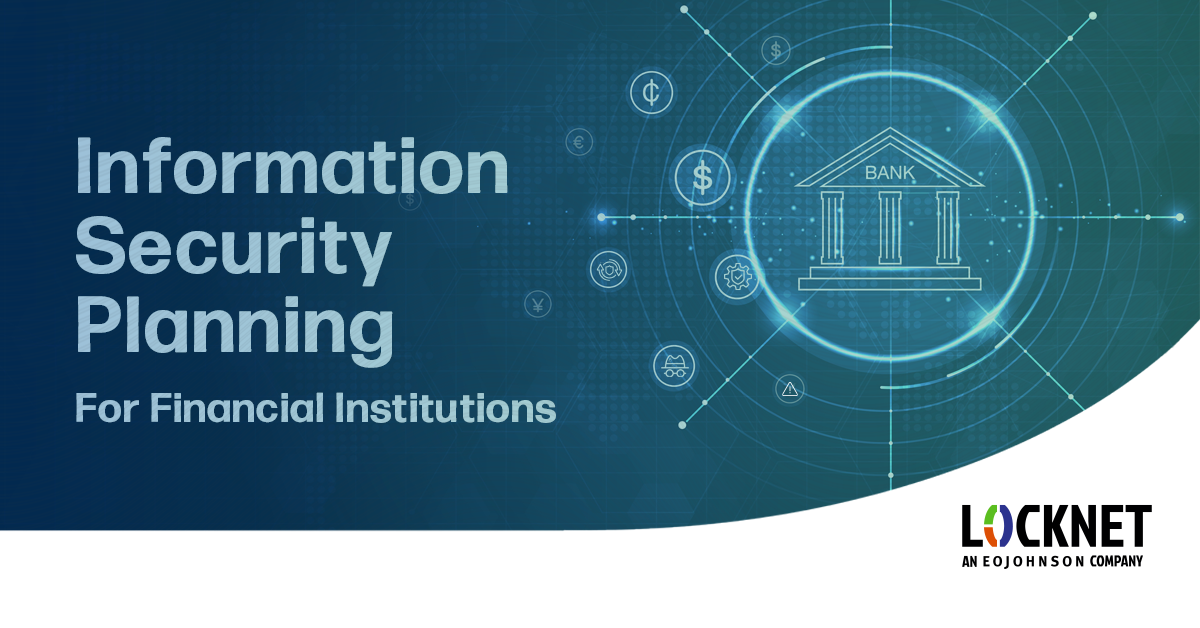Industries We Serve
World Class IT Support & Service
Real People. Right Now.
About Locknet® IT Services
From the first hello, the Locknet® team is dedicated to serving you and your needs.
Real People. Right Now.
From the first hello, the Locknet® team is dedicated to serving you and your needs.


In an era where cyber threats are evolving at an unprecedented pace, information security planning has become a critical component for financial institutions. Banks are prime targets for cybercriminals due to the sensitive nature of the data they handle and the number of electronic transactions that happen today. It’s estimated that 89% of adults in the U.S. now use digital payments. Effective information security planning and budgeting can help mitigate cyberthreats and ensure the safety of both customer data and institutional assets.
Before we dig into planning and budgeting, it’s crucial to understand the threat landscape. Cyber threats are constantly evolving, with hackers using advanced techniques like social engineering, phishing, ransomware, and insider threats to breach security defenses. Banks are particularly vulnerable due to the high value of the data they hold. This includes sensitive data, including personal identification information (PII), financial records, and payment transactions (ACH, wire transfers, and digital payments). In addition to external threats, internal vulnerabilities such as outdated software, inadequate access controls, and lack of employee training can also compromise information security.
The repercussions of a security breach can be catastrophic, leading to financial losses, reputational damage, and regulatory penalties. That’s why robust information security planning is crucial for maintaining trust and compliance with regulatory requirements.
Information security planning involves developing strategies and policies to protect an organization's data and information assets from unauthorized access, disclosure, alteration, or destruction. This process includes identifying potential threats, assessing vulnerabilities, and implementing measures to mitigate risks.
A well-structured security plan is the cornerstone of any bank’s defense strategy. Here are the key components to consider:
The first step in cyber security planning is conducting a thorough risk assessment. This involves identifying potential threats, such as malware and phishing scams, and evaluating both their likelihood and their impact on the organization. Implement a risk management framework that prioritizes risks based on their potential impact on the institution. This framework should guide the allocation of resources towards the most critical areas.
Develop and enforce comprehensive security policies and procedures for guiding employees' actions and ensuring consistent practices across the organization. Policies should cover areas such as password management, data encryption standards, access control protocols, and incident response procedures. Regularly review and update these policies to adapt to new threats and regulatory requirements.
Human error remains one of the leading causes of security breaches. Regular training sessions should be conducted to educate employees about common cyber threats, best practices, and procedures for mitigating them. Topics should include recognizing phishing emails, safe internet browsing habits, and proper handling of sensitive information. Implement a culture of security awareness where employees are encouraged to report suspicious activities and potential vulnerabilities.
Implementing advanced technologies can significantly enhance a bank's cyber defenses. Solutions such as firewalls, intrusion detection, encryption tools, and multi-factor authentication (MFA) can provide multiple layers of protection against various types of attacks.
Despite the best preventive measures, breaches can still occur. An effective incident response plan is crucial for minimizing damage. This plan should include clear protocols for detecting, responding to, and recovering from security incidents. It should also outline communication strategies for notifying stakeholders, including customers and regulators, in the event of a breach. Most importantly, this plan should be practiced and updated at least once a year.
Banks are subject to stringent regulations regarding data protection and information security, such as the Gramm-Leach-Bliley Act (GLBA) and the Payment Card Industry Data Security Standard (PCI DSS). Ensure that your security plan is fully compliant with these regulations. Regular audits should be conducted to assess compliance and identify areas for improvement.
Effective cyber security planning requires adequate budgeting. However, many banks struggle to allocate sufficient funds for information security due to competing priorities. Budgeting for information security requires a careful analysis of current needs versus available resources. Factors to consider include:
Information security is a critical component of any bank’s operations. With comprehensive cyber security planning and budget allocation, banks can protect themselves against the ever-evolving threat landscape. Remember that information security planning is a continuous process that requires ongoing attention and investment. By staying proactive, banks can safeguard their assets, maintain customer trust, and ensure their long-term success.
Locknet Managed IT is an MSSP with over thirty years of advanced cybersecurity expertise and training. We specialize in supporting the technology and security needs of financial institutions. Let’s talk about how we can not only be your managed IT partner, but also help improve your organization’s security posture.
Managed IT

Onalaska, WI Waterloo, IA Wausau, WI Eau Claire, WI Burnsville, MN
You are now leaving locknetmanagedit.com. Please check the privacy policy of the site you are visiting.